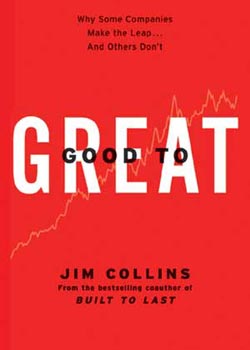I read Good to Greatlast semester and it is now the #1 book I would recommend to startup founders and leaders. The Hard Thing About Hard Things is still a very close #2, but this post examines the newest title champion of my bookshelf.
Too many founders stop (or never start) investing in their own personal growth. Yet they are surprised when their own ideas stagnate or their team continues to fall into the same patterns of failure.
As a co-op student or graduate, you may wonder why some companies you work at thrive but others are stagnant.
What are those key ingredients that you could start screening for in interviews to land work at successful companies?
Good to Great presents a data driven hypothesis of why some companies remain average, and how others succeed drastically more than their peers, industry, and the overall market.
Most of all it focuses on why being good is the enemy of being great.
This post is also a great excuse for you to crack a great book open and start investing again in yourself. It is worth it and as I have quoted before…
“The average American reads one book per year. The average millionaire reads one book per week.”
Next week, I will release part 3of my every-6ish-months book list (parts 1& 2)… but Good to Great deserved a post of its own.
Good to Great – Jim Collins

Author Jim Collins and his research team started with a question:
Why do some companies remain average, and others breakthrough to be hugely successful over decades?
The team combed through decades of stock market returns searching for pairs of companies in the same industry, that had similar size and performance.
In each final pairing, despite being similar in every metric, one company remained average for over a decade and the other firm soared above peers, industry, and market indexes for sustained, stellar performance.
Why did one succeed at such scale?
And more importantly for leaders of any team, how did they become great?
After interviewing management teams and employees, Collins distilled 8 key characteristics that defined the great companies and their leaders (and were noticeably lacking from their “good”, but not great, peers).

-
Level 5 Leadership: Defined not as the charismatic leaders society idolizes, Level 5’s are quiet, humble, and determined. Working hard to listen, lead with integrity and by example, they are more Lincoln than Patton or Caesar.
-
First Who…then What: Instead of starting with vision or strategy, Level 5’s always start with people. “Get the right people on the bus, the wrong people off the bus, and the right people in the right seats – and then they figured out where to drive it.” (Jim Collins)
I have underestimated the importance of this key to my own detriment and my own misunderstanding of another team’s success.
The right people will let your startup succeed, and the wrong can cause it to crumble before your eyes.
-
Confront the Brutal Facts (Yet Never Lose Faith): Like a Prisoner of War, a great leader and management team does not dilute themselves with false hope or blissful ignorance. They confront the facts no matter how brutal but at the same time hold an unwavering faith that they can and will succeed.
-
The Hedgehog Concept (Simplicity within the Three Circles): Referencing Isaiah Berlin’s famous essay, the world divides into foxes and hedgehogs by the Greek parable “The fox knows many things, but the hedgehog knows one big thing.” Specifically, the fox will try to be cunning, but the hedgehog wins with a single core strength of curling into a defensive ball of needles.
Every great company is the best in the world at something. No great company has a core business that is mediocre. Their core competencies always converge in the centre of these three questions:
- What are you deeply passionate about?
- What can you be the best in the world at?
- What drives your economic engine?
-
A Culture of Discipline: A self-disciplined group of people does not need hierarchy, bureaucracy, or excessive controls. Like the old adage that character is what you do when no one is looking, self-disciplined people with freedom still act with integrity and entrepreneurial spirit for the better of the firm.
Undisciplined people abuse freedom and require the negative bureaucratic controls that though partially effective, will never inspire the performance that self-disciplined people will inherently do.
-
Technology Accelerators: Most companies treat technology in one of two ways: like a fad that must be catered to reluctantly, or as the primary source of their future success. Yet great companies think of technology not as an end, but a means. They carefully choose and commit technologies that can accelerate existing successful processes.
-
Think about banks vs fintech. Banks resist and then reluctantly submit to new technologies. The primary value proposition of many fintech startups is not better technology, it is better customer experience.
Better technology is simply a more effective medium to provide new products, prices, and support to customers fed up with the bureaucracy, fees, and self-interest of big banks.
-
Or consider Research in Motion / Blackberry that believed technology like data-efficient networks and physical keyboards could be a primary, lasting competitive advantage. Paralyzed by their arrogance and internal chaos, they failed to see why the iPhone mattered until it was too late.
The iPhone soared because they delivered an email, internet, media, and app experience that anyone from 5 to 95 years old could use. People wanted the better experience and did not care if that cost them a keyboard, battery life, and higher cellular costs.
Blackberry made technology the product. Apple used technology as the medium for an experience.
Despite countless historical examples to learn from, I still see so many startups obliviously making this same mistake.
-
-
The Flywheel and the Doom Loop: Good companies do not become great overnight, or because of a single action or speech. They became great over time. It takes consistent effort in a single direction compounding throughout the organization. A breakthrough becomes inevitable not as a function of luck, but of resiliant momentum.
-
From Good to Great to Built to Last: Tying in Collin’s previous book on turning companies with great results into enduring great companies, great companies are deliberate in self-preservation. They develop processes and leaders that can endure the loss of charismatic leader, changing market conditions, or even a change to their core business.
Why Good to Great matters to founders
This book was clearly written for the MBA certified suits working at traditional corporations. Yet, the biggest problems I continue to see with startups stem from ignoring one, though usually many…or all, of these 8 concepts.
Whether it is ineffective leadership, not prioritizing people, or lacking the laser focus of a hedgehog concept, startups and small teams suffer from the same potentially fatal wounds that large corporations do.
The difference is that founders and small team leaders can change their heading much faster than big corporations.
It is just so much easier to change the heading of a small boat than a huge tanker.
According to Paul Graham, the issue is that most founders do not recognize they are on the wrong heading until it’s too late.
A core failing of most founders is that they do not take the time to invest in themselves. They “don’t have time” to keep learning, identify their own weaknesses, blind spots, and be brutally honest about areas where their team or startup is headed towards failure.
Fail to invest in yourself, and your investments tend to fail.
When founders cannot make the time to invest in themselves, it is not too surprising when they “don’t have time” to adequately focus on their startup’s strategy, roadmaps, employees, or customers.
Most founders simply end up “putting out fires”, convinced that their “busyness” is a sign of their proficiency as a leader, blindly ignorant of the real causes for their floundering startup.
One part of our culture I was very proud of at Teknically was our unyielding desire to keep reading and learning. We each read through almost 1 book per month on topics from startup financingto C.S. Lewis to UX design theory.
Regular reading gave us new ideas and perspectives to bounce off each other. With something other than our startup to think about and discuss, nightly and lunch reading also helped us stay sane as founders!
Consider the Following

I would encourage every founder to start reading again. Admit that you do not know everything. Keep learning. Prioritize your personal growth.
Because a better you, will make a better leader.
… and by better leader, I mean a Level 5 leader.
How do you kickstart your personal development? Your first mission should you choose to accept:
Start reading, and never stop.
Looking for other great books?
Good to Great was only one of the books I flipped through this winter and spring.
Check out other books I would recommend in parts 1, 2, and 3 of my leisure reading series.
Top Posts